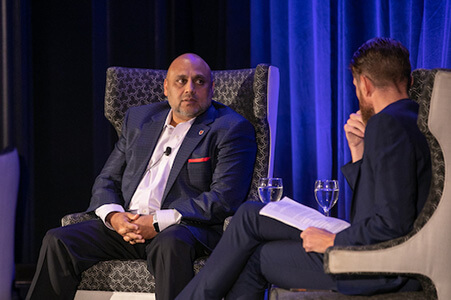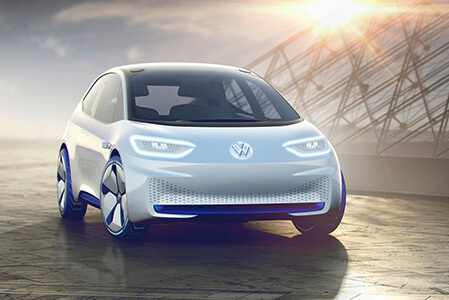 What have been some of the high points in logistics in your career?One is the swing toward providing a level of service that customers expect, as opposed to providing a level of service that we either think they need or that the system can provide. Those are two different things.
What have been some of the high points in logistics in your career?One is the swing toward providing a level of service that customers expect, as opposed to providing a level of service that we either think they need or that the system can provide. Those are two different things.
Traditionally, for an OEM, the customer is the dealership or the parts manager, or the service manager, or the new sales department. Ask them what they are looking for compared to a vehicle owner and the odds are you get a different answer. If you ask the vehicle owner and start to do what they are looking for, you will help drive customer satisfaction.
Take service parts as an example. What is the expectation for a customer on repairs? Is it drive in and wait, keep it overnight or keep it for a number of days? I drive in and I want it fixed while I wait and 30-45 minutes is the amount of time I’m willing to wait.
In the past, it was a scenario where the customer comes in and leaves the car at the facility and they get it back in a week. Now we need a change to customer focus.
If you start asking questions [about why a part is in stock] you get a customer focus, and you get faster and leaner. That is the big change I have seen in logistics, moving toward the vehicle owner as the customer.
Does finished vehicle logistics have further to go?I would say absolutely. Ask who the customers for vehicle logistics are. Is it the vehicle owner, is it the dealer, or is it our brand partners who are looking to hit a wholesale target? The answer is the latter.
If you are a vehicle owner, what is your expectation of vehicle delivery? We have some level of transparency now. If you are a customer and you know your car is scheduled to be built and when it is being built, great – you have a date. You now know when it is on a boat and when it has hit the US port. I’m not happy that it took 27 days and I can’t understand why it is at the port for two weeks. If it hits the US shore, I want the car tomorrow.
I love the fact we have transparency and we are giving it to the customers – but we have to ask if in giving them information, we are disappointing them. Do they care that we give our carriers three days to build efficient loads to get the car out of the port? Do they care that it takes two days to install an accessory that they ordered? No, [they say] that car is at a port 100 miles from my house, why can’t I go pick it up?
The simple answer is yes, we have a way to go but giving them this transparency is still less of a risk than giving them no transparency.
“I love the fact we have transparency and we are giving it to the customers – but we have to ask if in giving them information, we are disappointing them. Do they care that we give our carriers three days to build efficient loads to get the car out of the port? Do they care that it takes two days to install an accessory that they ordered? No, [they say] that car is at a port 100 miles from my house, why can’t I go pick it up?” - Anu Goel, Volkswagen Group of America
How do you raise the importance of logistics in the company’s overall decision-making process?I was always taught that our job was to identify opportunities and risks, and lay out what it took to materialise the opportunities and minimise the risks. So how do you do that? You have to fail to prove yourself right. That is a political risk.
Here is a real world situation: you say ‘this is what I think is going to happen’. Then you hear ‘I don’t believe you’. Then you go back to your team and you work to minimise the risk of what you told your boss was going to happen. If you make the risk go away, they say ‘see, I told you so’, without knowing what went into it behind the scenes. Or you fail, so what you said would happen actually materialises.
I’ve had meetings where I’ve said this or that will happen, based on years of experience with the facts lined up behind it. But what you are told is that you have to fail to prove you are right.
How do you get that elevated in an OEM? There are cost pressures. The lifeblood of an OEM is product development and if you can’t come up with cash to fund new vehicles, none of this stuff matters. That is the world we toil in but we work with good people and it is fun to figure it out.
It would be nice to have a bit more appreciation – a better understanding or a seat at the table. Maybe if we failed more often, people would believe us more often.
Can you give an insight into the decision-making process? What does it take to bring a new idea into a complex network and how much local initiative can you take and how much has to get signed off by Wolfsburg?After the issue we went through over the last couple of years, part of what we have done is restructure and a decision-making authority has been given to the North American region, which is cool. We have established a weekly North American leadership meeting and that is the opportunity to raise issues. The culture is starting to change where we are in control of our business and we have the authority with engineering and purchasing to make decisions here locally.
But for me there is a bigger move to bring logistics issues to the table. [Logistics] is now third on the list. It is now sales, financials and us. We have moved up. You have to have the force of personality. You could argue I have gained courage as I’ve gained years, but it is incumbent on logistics and operational leaders to make what we do known and get yourself elevated as a priority.
VW Group is one of the biggest in the world but not in the US. In the logistics sense, we talk about economies of scale but we also talk about nimbleness. Are you nimble where you need to be nimble? Are you big where you need to be big?A few years ago it was the opposite. I don’t get directives on how to run logistics in the North America region. I never have. I get comments on ‘that is not the way Spain, France and the UK do it, and they are the benchmark markets’. But take a map of Germany and overlay it on Texas or Minnesota and help them understand the size of this country.
One of the benefits of VW is we have the autonomy to run our region and we have the benefit of scale and size with the mothership.

What do you think will change the most for your team?The true game-changer from where I sit right now is the EV (electric vehicle). It will change the service parts business right away and we will have to go and find additional revenue streams. Are we prepared, infrastructure-wise, to handle these vehicles? We are getting there. We don’t have a firm grasp of the volume or the customers’ expectations for those. You can debate shared ownership, subscription services, ride-sharing. There is an article out there that says a third of the volume of vehicles sold in five years is going to be fleet. Fleet is on our radar screen in the US. What are the expectations of fleet owners for vehicles and service? Today we have ideas but we don’t have that figured out. How do you handle the batteries with dealers? What is the infrastructure going to be in this country? And then, when you start looking for additional revenue streams, it is about data but who owns the data? We are talking about privacy laws. All that comes into it.
Whoever is sitting in my chair in five to ten years from now is going to have a different job to the one I have today. What is truly changing the business is the fleet, the ride-sharing and how we will deal with EVs.
So you are not losing sleep over Nafta and tariffs?No. I will lose sleep over tweets but not that. You can plan, but how much are you going to invest in until you know for sure? Are we going to change our manufacturing footprint? You plan for how you would approach it but we are not changing anything until we know what is really happening. Focus on what you can focus on – and go from there.
[related_topics align=”right” border=”yes”]What excites you most about the future?I love what we do – the people and the brands. I like working to make things better and watching the team develop and learn. One of the things that concerns me in that regard is: what is the inner strength for people going into our business?
We have the technology that should attract people to our business. Get away from the typical smoke-stack stuff. Where is the talent coming from? We have 30% turnover in our business.
There are lots of reasons but when the workforce is turning over, where is the talent going? It isn’t the auto industry. Other industries value the training that we provide for people to go to other places. There is going to be more change in the next five years than in the 30 I have been in the business. That is exciting.
























